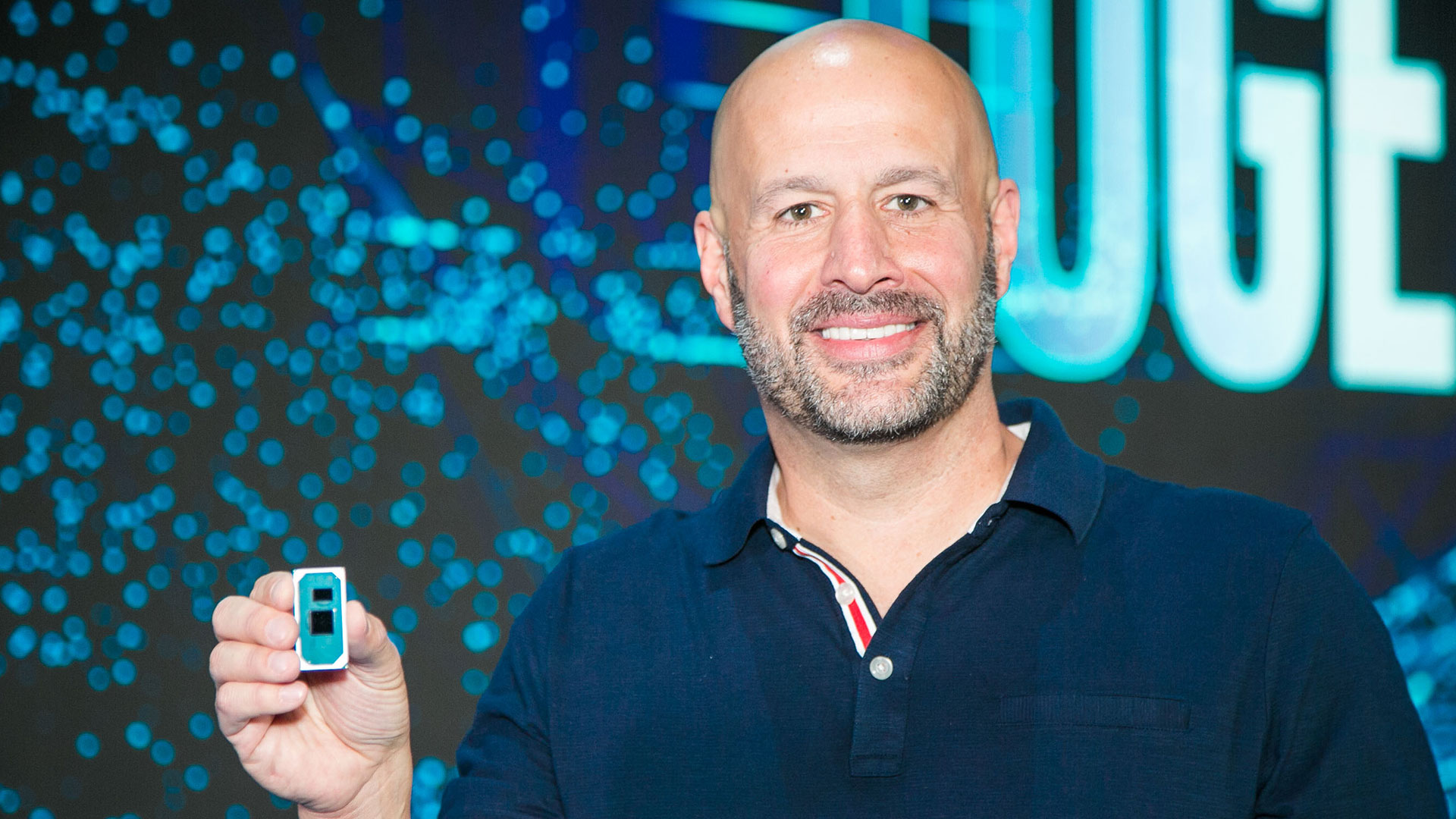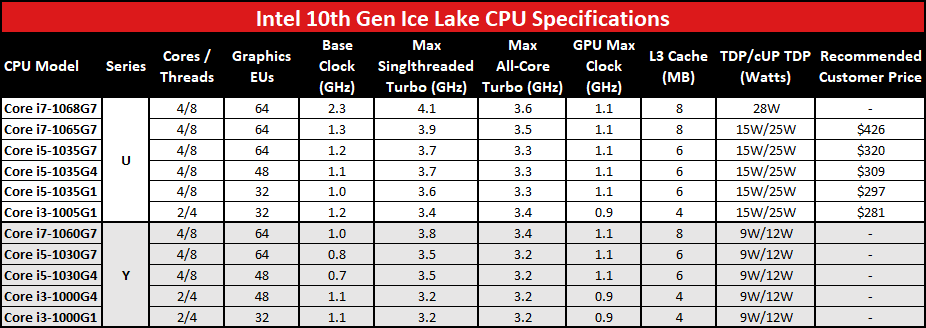Intel finally launches it's 10th Gen 10nm Ice Lake processors
11 mobile CPUs sporting improved IPC and Intel's fastest graphics ever.
Three years later than originally intended, Intel is finally launching a full family of 10nm processors. Fittingly, these will also be the first 10th Gen Core processors, and they bring many changes to Intel's CPU architecture. There's a bit of a catch, however, in that these initial Ice Lake parts will only be for mobile products. Perhaps that will change in the coming year, but with a sixth round of 14nm (+++ perhaps) desktop parts codenamed Comet Lake coming, there's a good chance Ice Lake will be solely for laptops. And more specifically, Ice Lake is currently only launching in 4-core and 2-core variants designed for ultrathin laptops—what Intel classifies as U-series and Y-series parts.
Naturally, 10th Gen CPUs mean new model names, and Intel has also updated its Core i3/i5/i7 branding. Initially, the model numbers can seem a bit weird as they look like a step back. We're going from part names like Core i7-8557U to new models like Core i7-1065G7. There's an extra digit tacked on at the end, but visually it looks like a jump from the 8th Gen 8000 family of CPUs (there were no 9000 family U- or Y-series CPUs) to the 10th Gen 1000 family. But the part numbers do actually make a bit more sense once you decode what they mean. Here's the full list of the 11 models launching today:
Let's quickly unpack the model numbers. There are six slightly higher power U-series parts and five Y-series parts. At present, all the Y-series processors have a zero in the fourth digit, while the U-series have either a five or an eight—with the latter being the sole 28W model. The first two digits are of course 10, for 10th Gen CPUs, and the third digit is basically the CPU family—zero for i3, three for i5, and six for i7 (because using 3/5/7 was too confusing or something). Finally, the fifth character is a G (presumably for graphics), and the last number represents the graphics configuration. G7 models have the full 64 EU configuration, G4 have 48 EUs, and G1 have 32 EUs. The G4 and G7 models also have Intel Iris Plus Graphics branding.
Clockspeeds, cache, and core counts are pretty straightforward. The base frequencies are extremely low on everything except the 28W model, which makes sense. If you have a U-series chip in a higher power ConfigUP state, you'll likely see much higher base frequencies as well. Maximum clockspeeds range from 3.2GHz on the Y-series i3 models, to 4.1GHz on the 1068G7, and Intel also discloses all-core maximum frequencies ranging from the same 3.2GHz, to as high as 3.6GHz on the 1068G7. GPU max clocks vary based on the CPU family: 0.9GHz on the Core i3, 1.05GHz on the Core i5, and 1.1GHz on the Core i7. The same goes for L3 cache: 8MB on i7, 6MB on i5, and 4MB on i3. Finally, all of the i7 and i5 models are 4-core/8-thread CPUs, and the Core i3 parts are 2-core/4-thread chips—I'd avoid these i3 parts, as I thing the days of 2-core processors being 'enough' have long since passed.
Intel hasn't disclosed pricing on any of the Y-series parts, or the 28W Core i7-1068G7. Of course, none of these prices really matter as you'll only be able to buy these as part of a notebook. Even the 'suggested' prices are basically meaningless, as things like the amount of RAM and SSD storage, display, and other features all factor into the final cost. I expect base model i3 laptops will start around $700, while Core i5 and above will cost $1,000 or more initially.
The Ice Lake processors all come in a package that features the CPU core next to a chipset, similar to the previous generation U- and Y-series parts. New to this generation is integrated support for both Thunderbolt 3 and Wi-Fi 6 (formerly 802.11ax) networking. Every CPU is capable of supporting up to four Thunderbolt 3 ports, as well as a 2x2 160MHz Wi-Fi stream with a maximum theoretical speed of 2.4Gbps—yes, potentially faster than even wired gigabit Ethernet.
Beyond the above specs, Intel is using the new Sunny Cove architecture, which includes quite a few updates. Ian over at AnandTech digs into the full details on the Sunny Cove architecture, but it's worth noting that this is the first real architectural update from Intel in four years. Skylake, Kaby Lake, Coffee Lake, and the Coffee Lake refresh all use the same basic architecture. Sunny Cove is finally something new.
Keep up to date with the most important stories and the best deals, as picked by the PC Gamer team.
The quick summary of changes is that Sunny Cove is deeper and wider than the Skylake variants. The reservation station can now dispatch up to 10 instructions per cycle, a 25 percent increase relative to Skylake. There are two additional pipelines (one AGU and one store data), and the L1 data cache bandwidth is effectively doubled. The L1 data cache is also 50 percent larger than before (48KB), which is the first change in L1 cache since Intel's first Core i7 parts rolled off the factory floor over a decade ago. Similarly, the L2 cache size per core has been doubled, from 256KB to 512KB. Add in a few other larger buffers like the micro-op cache and the reorder buffer, as well as some improvements in branch prediction accuracy. Finally, Sunny Cove brings AVX-512 support to the consumer line of CPUs for the first time—previously it was only available in Skylake-X CPUs (and the aborted Cannon Lake).
There's one other architectural change of note, Intel's new DL Boost and new AVX-512 instructions. Basically, Sunny Cove has some additional instructions that can improve the efficiency of certain complex math calculations. Intel is pushing the AI aspect with the DL Boost marketing name (DL = Deep Learning), but how this will play out in consumer laptops is nebulous at best. For the datacenter, DL Boost should improve the training speed of AI networks, while on clients it should improve the inference speed. But what sorts of inference will the laptops be doing? That's the part that isn't clear.
The real question is what sort of performance we can expect from Ice Lake and the Sunny Cove architecture. For this first round of products, the TDP is certainly going to be a factor. All of the maximum clockspeeds are unlikely to be sustained clockspeeds in most workloads, though the 28W part and cUP 25W laptops should manage higher sustained clocks. The CPUs can also short-term boost to draw as much as ~45W of power before dropping to the TDP. Regardless, Intel is aiming to make better use of the available power this round.
The bigger deal is going to be the graphics. Intel claims that it's new Gen11 graphics will be faster than any other integrated solution. And yes, that includes AMD's Vega 10 Graphics (though perhaps not the desktop Vega 11 Graphics).
Intel showed some performance slides at Computex where the Ice Lake 15W model took on a Whiskey Lake (i7-8565U) 15W part, with Ice Lake delivering anywhere from 42 percent to 108 percent more performance, depending on the game. Against AMD's Vega 10 Graphics in a 25W Ryzen 7 3700U, performance was much closer—the Ice Lake 25W part was a few percent slower in a couple of tests, and up to 16 percent faster in others, with an average lead of around seven percent. Game selection could of course be a factor, so we'll have to do some independent testing once we can get a laptop with one of these chips.
What about the CPU cores? Intel says Sunny Cove delivers on average 18 percent higher IPC (instructions per clock) compared to Skylake cores. The problem is that clockspeeds and power are also important factors. In a separate slide, Intel shows singlethreaded performance relative to a Broadwell U-series processor (the first 14nm parts released in late 2014 and early 2015). Ice Lake is nearly 50 percent faster than a 15W Broadwell processor in singlethreaded performance, but it's also only about 3-4 percent faster than a previous generation 8th Gen Whiskey Lake processor.
Those are Intel's numbers, and while we haven't been able to do any testing of Ice Lake ourselves, AnandTech again has some early performance results. 10th Gen Ice Lake generally beats 8th Gen Whiskey Lake at the same TDP, but not by a large margin in the CPU tests. Gaming performance is another story, however, with large gains in the games that were tested. Basically, Ice Lake has the potential to actually handle 1080p at low to medium quality in many games, without the need of a dedicated graphics card. Just don't expect high framerates at 1080p in more demanding games (eg, Assassin's Creed Odyssey).
Ultimately, Intel's mass produced 10nm processors are finally here—or will be soon enough. But there's still the strangeness of the upcoming Comet Lake CPUs, which will be yet another 14nm iteration on the core Skylake architecture. Those are rumored to be available with up to 6-core designs in a U-series part, with different naming conventions, but without the new architectural updates found in Sunny Cove / Ice Lake. Comet Lake will also be coming to desktops long before we see any 10nm desktop parts, based on what I've seen, and will hit higher clockspeeds in the mobile variants. Let's hope Intel's 7nm transition goes a bit better than 10nm.
Jarred's love of computers dates back to the dark ages when his dad brought home a DOS 2.3 PC and he left his C-64 behind. He eventually built his first custom PC in 1990 with a 286 12MHz, only to discover it was already woefully outdated when Wing Commander was released a few months later. He holds a BS in Computer Science from Brigham Young University and has been working as a tech journalist since 2004, writing for AnandTech, Maximum PC, and PC Gamer. From the first S3 Virge '3D decelerators' to today's GPUs, Jarred keeps up with all the latest graphics trends and is the one to ask about game performance.






